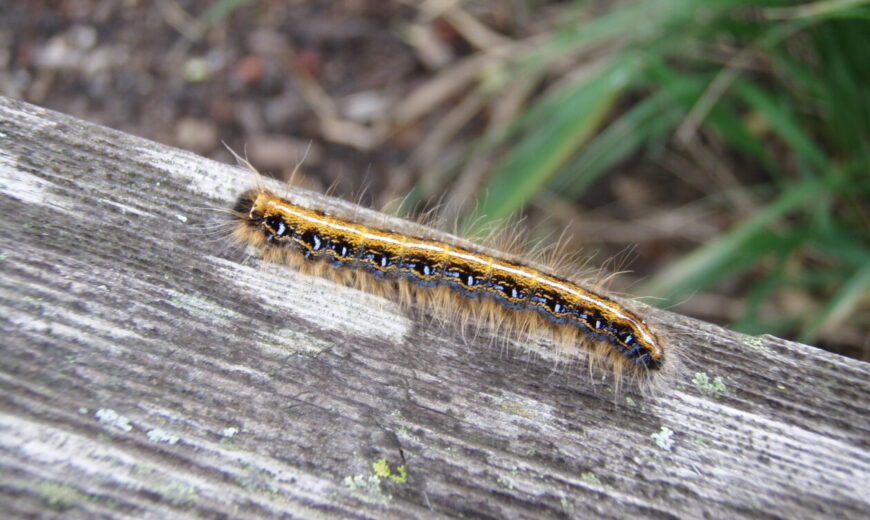In case you haven’t noticed, it’s tent season. Tour our local parks and forest preserves, even your own neighborhoods, on a weekend and you’re sure to see tents sheltering dozens, perhaps hundreds, of revelers. It’s graduation and wedding season, and celebrations are in full swing.
But if you own a fruit tree—apple, cherry, anything in the Rosaceae family—you’re probably aware of another tent season: that of the eastern tent caterpillar, Malacosoma americanum. And, if you’re like most people, you’re probably not thrilled about the party taking place among the branches.
Eastern tent caterpillars are the sort of guests most homeowners would like to uninvite. They move in, get comfortable and, when present in sufficiently high numbers, literally eat themselves out of house and home. Industrious larvae, their tents get larger and larger each day as they lay down layer upon layer of silk; meanwhile, the number of leaves on the home tree gets smaller and smaller as the caterpillars forage, feed and grow. When the time is right—and that time is now—the little critters leave the tent and wriggle off to pupate and become moths.
We’ve been seeing lots of tent caterpillars this past week, on paths and trails, sidewalks and streets. They’re a little over 2 in. long now and, dare I say it? Kinda pretty. Their blue bodies are covered with orangish-yellow hairs and spotted with two rows of white dots circled in black. A long creamy white stripe runs down the back and two thin orange stripes—caterpillar “bling”—add flair to the sides.
There’s no doubt, these guys are glitzy. And gluttonous. And, from a naturalist’s point of view, downright mesmerizing.
Tent caterpillars are social caterpillars, a trait that distinguishes them from most other baby butterflies and moths. They live communally in their tent and emerge en masse at three distinct time periods—before dawn, mid-afternoon and just after sunset. They take a little time to spin silk and enlarge their tent, then head off to feed. That’s when things get really interesting.
The first caterpillars to go out secrete pheromones, or behavior-influencing chemicals, in what are called “exploratory” trails. If successful—that is, if they find a lot of leaves—they feed, then return to the tent, laying down a second set of pheromones to create “recruitment” trails. With remarkable efficiency, other caterpillars then follow these trails to the leafy reward at the end. (Admit it, you’ll probably do the same thing at the upcoming summer festivals, following your senses to funnel cakes at Pride of the Fox Fest in St. Charles or bratwurst at Swedish Days in Geneva. I know I will…)
As they move about, the caterpillars also leave a trail of silk. Scientists studying such things have noted that it’s the pheromones more than the silk that the little larvae will follow. But for us humans, who lack the ability to sense caterpillar hormones, it’s the silk trails that are the most obvious. Look at a tree with a healthy tent caterpillar population and, if the light is right, you can see the trails running along the branches between tent and leaves, with the thickest trails leading to the richest food sources.
Back at the tent, the caterpillars bask, rest, and prepare for the next feeding bout. The enclosure functions as a silken greenhouse, collecting the sun’s rays and warming the occupants. Since the caterpillars’ insides must reach a temperature of 59F before they can metabolize food, the tent can be a lifesaver on cool spring days.
In our area, most tent caterpillars have reached the stage where it’s time to leave the tent and find a nice, quiet place to pupate. They’ll spin silken, creamy-white or yellow cocoons under rocks or logs, inside bark crevices or in leaf litter. If you find one, look closely; a lot of times you can see the pupa inside. But resist the urge to touch; the cocoons contain a powder that can be irritating to folks with sensitive skin.
After three or four weeks, the adult moths emerge and mate. The females then find a host tree and lay egg masses that circle the twigs; these blobs look a little like a fungus but, upon closer examination, are made up of teensy dark orbs. Inside, next year’s crop of tent caterpillars begin growing almost immediately. Then, after about three weeks’ time, they stop and enter diapause, a stage when all development stops. There they’ll remain until next spring, when growth resumes and tent season arrives once again.
This weekend, if you happen to find yourself in a tent, don’t forget about your caterpillar neighbors that no doubt are nearby. In fact, keep an eye open. You might find one, or a few, that have left their own tents and made their way—oh boy!—into yours.
Pam Otto is the manager of nature programs and interpretive services for the St. Charles Park District. She can be reached at potto@stcparks.org or 630-513-4346.

